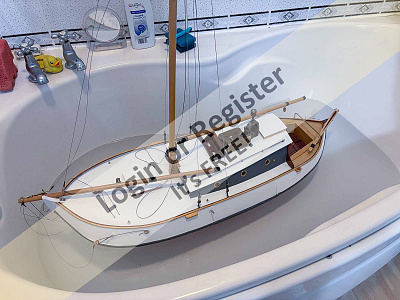Join Us On Social Media!
United Kingdom
Recent Posts
📝 Dutch sailing barge
7 days ago by 🇬🇧 AndyB2 ( Chief Petty Officer 2nd Class)
Chief Petty Officer 2nd Class)
 Chief Petty Officer 2nd Class)
Chief Petty Officer 2nd Class)✧ 11 Views · 6 Likes
Flag
📝 Reply
Have made a final float test - with all the RC equipment on board. Using some pieces of metal, it was possible to check how much weight was needed to load the boat down to the water line. This weight will be made by casting some lead shot and fixed to the end of the "false" keel.






▲
⟩⟩
SimonB2
EdW
Ronald
Mike W
AlessandroSPQR
hermank
Login To
Remove Ads
Remove Ads
📝 Dutch sailing barge
15 days ago by 🇬🇧 AndyB2 ( Chief Petty Officer 2nd Class)
Chief Petty Officer 2nd Class)
 Chief Petty Officer 2nd Class)
Chief Petty Officer 2nd Class)✧ 33 Views · 4 Likes
Flag
📝 Reply
The rigging is made from fishing line. It’s sold as trace wire, used for sea and pike fishing, 50lb. It’s supplied with small tube crimps and I then used a piece of heat shrink to cover these.
▲
⟩⟩
luckyduck
RNinMunich
hermank
Ronald
📝 Dutch sailing barge
16 days ago by 🇬🇧 AndyB2 ( Chief Petty Officer 2nd Class)
Chief Petty Officer 2nd Class)
 Chief Petty Officer 2nd Class)
Chief Petty Officer 2nd Class)✧ 31 Views · 11 Likes
Flag
📝 Reply
Have completed the rigging and made some "paper" sails, as templates. Next step will be some "real" sails and then checking the operation of all the servos - the final task will be a float text and to consider how much lead will be needed - and there will be all those small details and finishing touches - which are forgotten until the end!












▲
⟩⟩
EdW
Mike W
DuncanP
Newby7
chugalone100
roycv
RNinMunich
Ronald
Mike Stoney
AlessandroSPQR
hermank
📝 Model Boat Show
18 days ago by 🇬🇧 AndyB2 ( Chief Petty Officer 2nd Class)
Chief Petty Officer 2nd Class)
 Chief Petty Officer 2nd Class)
Chief Petty Officer 2nd Class)✧ 18 Views · 5 Likes
Flag
📝 Reply
Went along on Saturday seemed busy
Some impressive models. Hope the trade suppliers found it worth while. Yes I did buy some things. A lot of effort put in by some exhibitors.
There was an impressive model of the Mulberry harbour. Would have been interested to find out more about how it was made. Parts 3D printed?
Worth a visit if you’ve not been before, hopefully next year will be as good. Please try to encourage more sailing boats to be exhibited.
Not the organisers fault but the catering facilities could have been better. I’d have thought the hotel would have seen an opportunity, as it’s not got the best reputation locally.
Some impressive models. Hope the trade suppliers found it worth while. Yes I did buy some things. A lot of effort put in by some exhibitors.
There was an impressive model of the Mulberry harbour. Would have been interested to find out more about how it was made. Parts 3D printed?
Worth a visit if you’ve not been before, hopefully next year will be as good. Please try to encourage more sailing boats to be exhibited.
Not the organisers fault but the catering facilities could have been better. I’d have thought the hotel would have seen an opportunity, as it’s not got the best reputation locally.
▲
⟩⟩
Rookysailor
hermank
RNinMunich
Nickthesteam
Steves-s
📝 Dutch sailing barge
23 days ago by 🇬🇧 AndyB2 ( Chief Petty Officer 2nd Class)
Chief Petty Officer 2nd Class)
 Chief Petty Officer 2nd Class)
Chief Petty Officer 2nd Class)✧ 38 Views · 11 Likes
Flag
📝 Reply
Made a little more progress. The prop shaft has been fitted and works, even had a quick go in the bath.
The sail and rudder servos have also been installed, seem to work ok. The next stage will be the standing rigging, before making some paper templates for the sails.







The sail and rudder servos have also been installed, seem to work ok. The next stage will be the standing rigging, before making some paper templates for the sails.







▲
⟩⟩
EdW
Mike W
DuncanP
chugalone100
Mike Stoney
xtramaths
SimonB2
ChrisF
LewZ
Ronald
hermank
📝 Dutch sailing barge
2 months ago by 🇬🇧 AndyB2 ( Chief Petty Officer 2nd Class)
Chief Petty Officer 2nd Class)
 Chief Petty Officer 2nd Class)
Chief Petty Officer 2nd Class)✧ 49 Views · 4 Likes
Flag
📝 Reply
The drawings are from Sarik
Dutch Yacht MM1203 Static Sail Plan
However, these are for a model that is 18.5 inches long. So I got the drawings scanned and then doubled the size on the computer before printing them out again.
The drawings are based on the Vollenhovense Bol design - a quick search will show many examples.
I've kept a blog, which shows more photos.
Dutch Yacht MM1203 Static Sail Plan
However, these are for a model that is 18.5 inches long. So I got the drawings scanned and then doubled the size on the computer before printing them out again.
The drawings are based on the Vollenhovense Bol design - a quick search will show many examples.
I've kept a blog, which shows more photos.
▲
⟩⟩
Mike W
Ronald
hermank
EdW
📝 Dutch sailing barge
2 months ago by 🇬🇧 AndyB2 ( Chief Petty Officer 2nd Class)
Chief Petty Officer 2nd Class)
 Chief Petty Officer 2nd Class)
Chief Petty Officer 2nd Class)✧ 52 Views · 4 Likes
Flag
📝 Reply
One of the RC channels will control a motor. The keel was made in two pieces, so a grove could be cut, so once the two halves were glued together there was a channel so the prop shaft can be fitted.
The system works when tested on the “bench”. How effective it will be in propelling the boat along is yet to be seen. The hull shape is hardly “streamlined” and making the hull has had its challenges!
The system works when tested on the “bench”. How effective it will be in propelling the boat along is yet to be seen. The hull shape is hardly “streamlined” and making the hull has had its challenges!
▲
⟩⟩
DuncanP
hermank
Ronald
luckyduck
📝 Dutch sailing barge
2 months ago by 🇬🇧 AndyB2 ( Chief Petty Officer 2nd Class)
Chief Petty Officer 2nd Class)
 Chief Petty Officer 2nd Class)
Chief Petty Officer 2nd Class)✧ 52 Views · 9 Likes
Flag
📝 Reply
Have been distracted again but now returned to finishing off the Dutch barge. The hull is now painted and varnished, have also made the spars - the next step is to add the fittings and get the sails fitted.
Will then add the RC equipment, before doing a float test, to find out how much lead is needed to pull it down to the water line.




Will then add the RC equipment, before doing a float test, to find out how much lead is needed to pull it down to the water line.




▲
⟩⟩
Mike Stoney
hermank
Mike W
EdW
Ronald
SimonB2
AlessandroSPQR
roycv
luckyduck
📝 Dutch sailing barge
12 months ago by 🇬🇧 AndyB2 ( Chief Petty Officer 2nd Class)
Chief Petty Officer 2nd Class)
 Chief Petty Officer 2nd Class)
Chief Petty Officer 2nd Class)✧ 53 Views · 1 Like
Flag
📝 Reply
Roy is right about using model railway parts. The handrail knobs are from a model engineering supplier and are intended for a 5 inch gauge loco, the actual handrail is 2mm dia. stainless steel, which just about fits the aprox. 1:10 scale that I'm working to.
As for painting, there is an initial two coats of thinned varnish and then a spray coat of a "filler primer" from Halfords. A fine modelling filler/putty is used to fill small imperfections, before rubbing down with some wet n dry. This process was repeated on two more occasions. The top coats will be completed using a spray paint from B&Q, aimed at furniture restoration. There are a selection of colours and the white is available in gloss, satin and matt finishes. The other option is car spray but tends to be glossy finish.
The red oxide, below the waterline, is a red primer from Halfords.
As for painting, there is an initial two coats of thinned varnish and then a spray coat of a "filler primer" from Halfords. A fine modelling filler/putty is used to fill small imperfections, before rubbing down with some wet n dry. This process was repeated on two more occasions. The top coats will be completed using a spray paint from B&Q, aimed at furniture restoration. There are a selection of colours and the white is available in gloss, satin and matt finishes. The other option is car spray but tends to be glossy finish.
The red oxide, below the waterline, is a red primer from Halfords.
▲
⟩⟩
hermank
📝 Dutch sailing barge
12 months ago by 🇬🇧 AndyB2 ( Chief Petty Officer 2nd Class)
Chief Petty Officer 2nd Class)
 Chief Petty Officer 2nd Class)
Chief Petty Officer 2nd Class)✧ 49 Views · 1 Like
Flag
📝 Reply
Have used spray paints for the hull. However, varnish does come from a tin but tend decant some into a jam jar, which means that opening the tin is kept to a minimum, especially if it is being used on a daily basis. The varnish in the jam jar is thinned 50/50 with white sprit.
▲
⟩⟩
roycv
📝 Dutch sailing barge
12 months ago by 🇬🇧 AndyB2 ( Chief Petty Officer 2nd Class)
Chief Petty Officer 2nd Class)
 Chief Petty Officer 2nd Class)
Chief Petty Officer 2nd Class)✧ 42 Views · 8 Likes
Flag
📝 Reply
Before going any further with the deck and rigging, felt that the hull should be "faired" and given an initial coat of paint. In fact it ended up with three coats of primer (yellow), with some fine filler used in places, rubbing down between coats. The final overall colour will be white, with a red oxide under the water line. A initial "dusting" of white confirmed there is no conflict between the two paints.




▲
⟩⟩
Mike Stoney
Mike W
SimonB2
Peejay
AlessandroSPQR
chugalone100
Ronald
hermank
Login To
Remove Ads
Remove Ads
📝 Dutch sailing barge
12 months ago by 🇬🇧 AndyB2 ( Chief Petty Officer 2nd Class)
Chief Petty Officer 2nd Class)
 Chief Petty Officer 2nd Class)
Chief Petty Officer 2nd Class)✧ 39 Views · 8 Likes
Flag
📝 Reply
The roof is finished - using stainless steel for the handrail. Have also started to shape the lee boards. There is a need to think about other details, shroud fixing etc. There are a number of additional "wooden" parts that can be seen on photos of "real boats" which need to be added.
The underside of the hull needs priming and sanded smooth - think that will be the next task.



The underside of the hull needs priming and sanded smooth - think that will be the next task.



▲
⟩⟩
Mike Stoney
Mike W
SimonB2
Peejay
roycv
Ronald
luckyduck
hermank
📝 Dutch sailing barge
1 year ago by 🇬🇧 AndyB2 ( Chief Petty Officer 2nd Class)
Chief Petty Officer 2nd Class)
 Chief Petty Officer 2nd Class)
Chief Petty Officer 2nd Class)✧ 45 Views · 4 Likes
Flag
📝 Reply
Thanks for the interest. I’ve not given up on adding a control to the Lee boards but at the moment it’s not on the “must do” list. I’ve struggled to find examples of other Dutch barge models, so it’s good to hear someone else has built one.
I’ll look at painting and finishing the cabin roof, then the next job will be the Lee boards.
I’ll look at painting and finishing the cabin roof, then the next job will be the Lee boards.
▲
⟩⟩
Ronald
Mike Stoney
AlessandroSPQR
hermank
📝 Dutch sailing barge
1 year ago by 🇬🇧 AndyB2 ( Chief Petty Officer 2nd Class)
Chief Petty Officer 2nd Class)
 Chief Petty Officer 2nd Class)
Chief Petty Officer 2nd Class)✧ 47 Views · 8 Likes
Flag
📝 Reply
The cabin now has a roof. This lifts off and then its possible to lift out the door and cockpit, which should provide good access to the inside of the hull.
The handrail along the edge of the roof needs to be added but I'll need some 2mm dia brass rod and will then add a further 4 supports each side.



The handrail along the edge of the roof needs to be added but I'll need some 2mm dia brass rod and will then add a further 4 supports each side.



▲
⟩⟩
Mike W
SimonB2
chugalone100
EdW
AlessandroSPQR
hermank
Mike Stoney
roycv
📝 Dutch sailing barge
1 year ago by 🇬🇧 AndyB2 ( Chief Petty Officer 2nd Class)
Chief Petty Officer 2nd Class)
 Chief Petty Officer 2nd Class)
Chief Petty Officer 2nd Class)✧ 50 Views · 3 Likes
Flag
📝 Reply
A bought a pack of three capacitors, so will have the option, currently working on cockpit floor, door and finishing rudder.
▲
⟩⟩
hermank
Mike Stoney
AlessandroSPQR
📝 Karoline, Dutch potato boat.
1 year ago by 🇬🇧 AndyB2 ( Chief Petty Officer 2nd Class)
Chief Petty Officer 2nd Class)
 Chief Petty Officer 2nd Class)
Chief Petty Officer 2nd Class)✧ 10 Views · 1 Like
Flag
📝 Reply
Lovely model, sorry to see the damage. Interesting to learn more about how you built the hull. Am currently building a similar boat and the shape of the hull has proved a “challenge” to build.
▲
⟩⟩
Rogal118
📝 Dutch sailing barge
1 year ago by 🇬🇧 AndyB2 ( Chief Petty Officer 2nd Class)
Chief Petty Officer 2nd Class)
 Chief Petty Officer 2nd Class)
Chief Petty Officer 2nd Class)✧ 52 Views · 11 Likes
Flag
📝 Reply
Been a bit distracted recently but have now wired the RC system together and decided how it will fit in the boat. Still need to add a fuse and capacitors for the motor but it does all work.
Made some card templates for the pieces of deck, before making and fitting the final pieces.




Made some card templates for the pieces of deck, before making and fitting the final pieces.




▲
⟩⟩
Mike W
SimonB2
chugalone100
EdW
IanL1
hermank
Mike Stoney
roycv
Len1
AlessandroSPQR
luckyduck
📝 Karoline,
1 year ago by 🇬🇧 AndyB2 ( Chief Petty Officer 2nd Class)
Chief Petty Officer 2nd Class)
 Chief Petty Officer 2nd Class)
Chief Petty Officer 2nd Class)✧ 21 Views · 3 Likes
Flag
📝 Reply
A great looking model and pleasing to see a traditional sailing boat being built. Be interesting to see how well it sails and how you’ve set the sail controls up.
▲
⟩⟩
Len1
Rogal118
hermank
📝 Dutch sailing barge
1 year ago by 🇬🇧 AndyB2 ( Chief Petty Officer 2nd Class)
Chief Petty Officer 2nd Class)
 Chief Petty Officer 2nd Class)
Chief Petty Officer 2nd Class)✧ 47 Views · 3 Likes
Flag
📝 Reply
Thanks
The next step is to get the rudder and sail servos in and working, along with the motor control. That will use all the controls up on the Rx/Rc. Not using the motor control would make room for a servo/winch for the Lee boards. Decisions ?
Unfortunately I don’t subscribe to Facebook etc but thanks for the suggestion
The next step is to get the rudder and sail servos in and working, along with the motor control. That will use all the controls up on the Rx/Rc. Not using the motor control would make room for a servo/winch for the Lee boards. Decisions ?
Unfortunately I don’t subscribe to Facebook etc but thanks for the suggestion
▲
⟩⟩
Len1
AlessandroSPQR
hermank
📝 Dutch sailing barge
1 year ago by 🇬🇧 AndyB2 ( Chief Petty Officer 2nd Class)
Chief Petty Officer 2nd Class)
 Chief Petty Officer 2nd Class)
Chief Petty Officer 2nd Class)✧ 63 Views · 10 Likes
Flag
📝 Reply
Thanks Alessandro. Slightly to my surprise - I've struggled to find other models of Dutch barges - a few YouTube clips and that's it. There is more information about the building of model Thames Barges, which are similar in design to the Dutch version. These models seem to use a rudder extension and additional keel, I have designed/built the hull to incorporate a bolt on keel, just in case. It would be nice to avoid both of these and allow the use of the lee boards as on the full size boat.
It could be possible to use a sail winch mounted sides ways, so the lee boards could be raised and lifted, on a push/pull arrangement - but the boards would need to be weighted to ensure they dropped as the line from the winch was eased. The other option would just have them adjustable and made so they could be fixed in a down position.
All ideas to be considered.


It could be possible to use a sail winch mounted sides ways, so the lee boards could be raised and lifted, on a push/pull arrangement - but the boards would need to be weighted to ensure they dropped as the line from the winch was eased. The other option would just have them adjustable and made so they could be fixed in a down position.
All ideas to be considered.


▲
⟩⟩
SimonB2
chugalone100
Mike Stoney
Razor1955
Len1
hermank
BarryS
Peejay
EdW
AlessandroSPQR
📝 Dutch sailing barge
1 year ago by 🇬🇧 AndyB2 ( Chief Petty Officer 2nd Class)
Chief Petty Officer 2nd Class)
 Chief Petty Officer 2nd Class)
Chief Petty Officer 2nd Class)✧ 69 Views · 11 Likes
Flag
📝 Reply
Here's a couple of photos with the outer gunwales fitted and topsides trimmed, which shows the true shape of the hull.




▲
⟩⟩
SimonB2
chugalone100
Razor1955
Peejay
EdW
Len1
AlessandroSPQR
roycv
Brightwork
luckyduck
hermank
Login To
Remove Ads
Remove Ads
📝 Dutch sailing barge
1 year ago by 🇬🇧 AndyB2 ( Chief Petty Officer 2nd Class)
Chief Petty Officer 2nd Class)
 Chief Petty Officer 2nd Class)
Chief Petty Officer 2nd Class)✧ 69 Views · 11 Likes
Flag
📝 Reply
A little bit of progress. The rudder is fitted, along with the servo. The green/yellow acrylic extension is easy to remove but should improve the rudders performance, it can be shortened if the current size proves to big.
The topsides are made from 1.5mm thick plywood. The line of the gunwale has been marked out and this will be glued in place, before the excess plywood is trimmed off.
Currently thinking about where/how the two sail winch arms will be fitted - the plan is to use two HiTec 765's. The roof of the cabin will be removable, as will the the cockpit - but have yet to decide how to achieve this.





The topsides are made from 1.5mm thick plywood. The line of the gunwale has been marked out and this will be glued in place, before the excess plywood is trimmed off.
Currently thinking about where/how the two sail winch arms will be fitted - the plan is to use two HiTec 765's. The roof of the cabin will be removable, as will the the cockpit - but have yet to decide how to achieve this.





▲
⟩⟩
SimonB2
chugalone100
Mike Stoney
Razor1955
Peejay
EdW
AlessandroSPQR
Brightwork
Len1
hermank
jbkiwi
📝 Dutch sailing barge
1 year ago by 🇬🇧 AndyB2 ( Chief Petty Officer 2nd Class)
Chief Petty Officer 2nd Class)
 Chief Petty Officer 2nd Class)
Chief Petty Officer 2nd Class)✧ 75 Views · 6 Likes
Flag
📝 Reply
Making mistakes - the greatest learning tool?
Colour? White initially, then perhaps red oxide or black under the water line. Think the rubbing strake will black, but that’s all along way off. A few coats of white and lots of rubbing down will be needed first.
Next task, the rudder and operation via a servo.
Colour? White initially, then perhaps red oxide or black under the water line. Think the rubbing strake will black, but that’s all along way off. A few coats of white and lots of rubbing down will be needed first.
Next task, the rudder and operation via a servo.
▲
⟩⟩
Mike Stoney
AlessandroSPQR
hermank
Len1
Razor1955
Peejay
📝 Dutch sailing barge
1 year ago by 🇬🇧 AndyB2 ( Chief Petty Officer 2nd Class)
Chief Petty Officer 2nd Class)
 Chief Petty Officer 2nd Class)
Chief Petty Officer 2nd Class)✧ 71 Views · 12 Likes
Flag
📝 Reply
So I'm glad that Dutch barges do not have a varnish finish, such as a classic carvel built yacht. Some sanding and Isopon P38 meant the hull was reasonably "fair". However, the planking is only 1.5mm thick, so added a layer of glass fibre tissue with West Epoxy. Once cured this was sanded smooth, with some smaller marks filled with P38, before a final sand. An initial coat of thinned varnish has now been applied. The plan is to give a few more coats before another fine sand. The hull will be finally painted - not certain what colour yet.












▲
⟩⟩
SimonB2
chugalone100
EdW
Brightwork
jbkiwi
luckyduck
Razor1955
Peejay
flaxbybuck
hermank
AlessandroSPQR
Len1
📝 Dutch sailing barge
1 year ago by 🇬🇧 AndyB2 ( Chief Petty Officer 2nd Class)
Chief Petty Officer 2nd Class)
 Chief Petty Officer 2nd Class)
Chief Petty Officer 2nd Class)✧ 70 Views · 6 Likes
Flag
📝 Reply
I assume a second layer of planking may smooth things out but it seems reasonable at the moment and with some sanding and filler it should be ok. To be honest, I found the planking a little frustrating and not my greatest pleasure - so one layer will have to do !
Thanks for the video Ross - interesting but the challenge on a Dutch barge (or similar) is the bow, where the planks have to bend round 90 degrees, as the bow has the cross-section of a football, rather than a fine cutting edge, as found on a classic J class yacht.
Thanks for the video Ross - interesting but the challenge on a Dutch barge (or similar) is the bow, where the planks have to bend round 90 degrees, as the bow has the cross-section of a football, rather than a fine cutting edge, as found on a classic J class yacht.
▲
⟩⟩
Brightwork
Peejay
Razor1955
Len1
hermank
AlessandroSPQR
📝 Dutch sailing barge
1 year ago by 🇬🇧 AndyB2 ( Chief Petty Officer 2nd Class)
Chief Petty Officer 2nd Class)
 Chief Petty Officer 2nd Class)
Chief Petty Officer 2nd Class)✧ 61 Views · 9 Likes
Flag
📝 Reply
Have managed to finish the planking - not a perfect result - but the next task will be some filler and sanding, on the outside, to try and get a reasonably fair hull shape. Have coated the inside with some West epoxy, this should fill any gaps between the planks - chalking - and give improve the strength.
I'd be interested to see how the planking is completed on the full size version, as it seems they use fewer but wider planks.





I'd be interested to see how the planking is completed on the full size version, as it seems they use fewer but wider planks.





▲
⟩⟩
SimonB2
chugalone100
Trident73
Doogle
Razor1955
Len1
AlessandroSPQR
roycv
hermank
📝 Dutch sailing barge
1 year ago by 🇬🇧 AndyB2 ( Chief Petty Officer 2nd Class)
Chief Petty Officer 2nd Class)
 Chief Petty Officer 2nd Class)
Chief Petty Officer 2nd Class)✧ 61 Views · 5 Likes
Flag
📝 Reply
Using a motor? - Certainly useful to beat a falling tide when coming into a drying harbour.
▲
⟩⟩
Brightwork
Razor1955
Len1
hermank
RNinMunich
📝 Dutch sailing barge
1 year ago by 🇬🇧 AndyB2 ( Chief Petty Officer 2nd Class)
Chief Petty Officer 2nd Class)
 Chief Petty Officer 2nd Class)
Chief Petty Officer 2nd Class)✧ 61 Views · 6 Likes
Flag
📝 Reply
Originally there had be no intention to include a motorised prop, the plan being for just a propeller on a false shaft for pure aesthetic reasons. It is a sailing boat and I’ll admit to having no interest in powered craft.
However, as we should always be interested in learning new things, the decision was made to add the auxiliary power source. The actual prop size is currently 40mm, which just fits. I look some advice and the motor size was recommended, as was the specification for the speed controller. The motor/prop will only need to move the boat slowly when there is no wind, but that is along way off yet and we need to remember it is a sailing boat.
You can still hire sailing cruisers on the Norfolk Broads that do not have a motor. Such joy and thus skill needed.
However, as we should always be interested in learning new things, the decision was made to add the auxiliary power source. The actual prop size is currently 40mm, which just fits. I look some advice and the motor size was recommended, as was the specification for the speed controller. The motor/prop will only need to move the boat slowly when there is no wind, but that is along way off yet and we need to remember it is a sailing boat.
You can still hire sailing cruisers on the Norfolk Broads that do not have a motor. Such joy and thus skill needed.
▲
⟩⟩
Brightwork
Len1
hermank
Razor1955
roycv
Peejay
📝 Dutch sailing barge
1 year ago by 🇬🇧 AndyB2 ( Chief Petty Officer 2nd Class)
Chief Petty Officer 2nd Class)
 Chief Petty Officer 2nd Class)
Chief Petty Officer 2nd Class)✧ 63 Views · 9 Likes
Flag
📝 Reply
Six Planks - however the challenge is yet to come. As the bow rises in the front third of the boat, the space between the flat bottom and side rubbing strake increases. This will create a problem - which will need to be filled with some additional tapered planks. Unless anyone else has some ideas?






▲
⟩⟩
SimonB2
chugalone100
Brightwork
Peejay
Razor1955
AlessandroSPQR
Len1
MartinW
hermank
📝 Dutch sailing barge
1 year ago by 🇬🇧 AndyB2 ( Chief Petty Officer 2nd Class)
Chief Petty Officer 2nd Class)
 Chief Petty Officer 2nd Class)
Chief Petty Officer 2nd Class)✧ 74 Views · 12 Likes
Flag
📝 Reply
Started the planking - something I have no experience of. The barge hasn't the fine lines of a classic J class yacht, so the planks for bow/stern do need some pre bending. Have completed the top two planks, not perfect but plan to add a coat of west epoxy, before sanding smooth. The planks are visible on full size/real boat, so am happy for some planking lines on the model.
Decided to add the flat bottom, from 1.5mm ply, an initial paper template helped get the shape close, before final fitting. Plan is to then add two lines of planks at the bottom, before completing the rest.





Decided to add the flat bottom, from 1.5mm ply, an initial paper template helped get the shape close, before final fitting. Plan is to then add two lines of planks at the bottom, before completing the rest.





▲
⟩⟩
SimonB2
chugalone100
Brightwork
Peejay
Razor1955
MartinW
MartyV
Len1
hermank
flaxbybuck
SimpleSailor
luckyduck





 Rear Admiral)
Rear Admiral)

 Fleet Admiral)
Fleet Admiral)

 Liked Dutch sailing barge 7 days ago
Liked Dutch sailing barge 7 days ago
 Liked Dutch sailing barge 8 days ago
Liked Dutch sailing barge 8 days ago
 Liked Dutch sailing barge 14 days ago
Liked Dutch sailing barge 14 days ago
 Liked Dutch sailing barge 15 days ago
Liked Dutch sailing barge 15 days ago





















